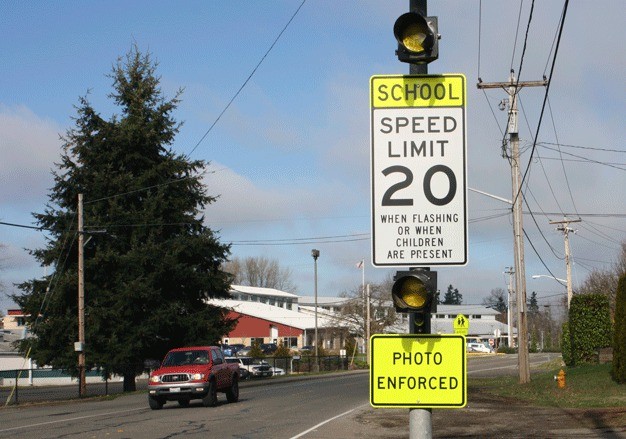Traffic cameras to catch speeders in school zones are coming this fall to Kent.
The Kent City Council unanimously approved plans last week to install cameras on streets in front of Sunrise Elementary on the East Hill and Neely-O’Brien Elementary in the Valley.
The program initially is projected to bring in an estimated $421,000 in the first year to the city, according to city documents.
“Funds (from tickets paid) will pay for the program,” said Pat Fitzpatrick, deputy city attorney, at a May 21 council workshop. “If there are leftover funds, the money will be used to enforce traffic and criminal infractions.”
Tickets will cost $124 for drivers going 1 to 9 mph over the 20 mph speed limit and $248 for drivers 10 mph or more over the limit.
The city will contract with Arizona-based American Traffic Solutions (ATS), Inc., to provide the camera services that include the equipment as well as mailing out tickets. ATS contracts with Des Moines, Seattle, Federal Way, Issaquah and more than 300 other communities in 21 states to provide traffic camera services.
The program will cost the city about $150,000 per year, including $97,000 to ATS for the four cameras; $20,000 for pay to police officers to review the video; $26,000 for Municipal Court staff; and $7,000 for city legal staff.
Revenue from the first year is projected to be $571,000 based on the number of speeders who exceeded 20 mph during the traffic studies at Sunrise and Neely-O’Brien.
“Those two schools were chosen because of the (speeding traffic study) numbers and rate of infractions were the highest,” Fitzpatrick said. “Sunrise is on a long road without many stops. We will have the biggest impact at those two schools.”
City traffic studies showed 964 vehicles passed Sunrise, 22300 132nd Ave. S.E., when the school-zone lights flashed for 20 mph speed on April 25 for the 30 minutes before school starts and 30 minutes when school ends. A total of 755 vehicles exceeded the 20 mph speed, including 225 going more than 30 mph.
“There’s not enough police staff to cover all of the school zones,” Fitzpatrick said. “When the speed is over 30 mph and a pedestrian is involved, the fatality rate goes up dramatically. Other cities with cameras have reported dramatic reduction in school zone speeding. This program is aimed at reducing speeds in school zones.”
Cameras will take a video and still images of a speeding vehicle from behind. Speed is measured by sensors in the road. After review by a police officer, ATS staff will send a ticket to the vehicle’s registered owner. The cameras only take images of the vehicle and license plate, not the driver or passengers.
Police officers who review video will receive overtime pay so that officers are not taken off the street and current service levels are maintained, Fitzpatrick said.
“The goal is for the program to pay for the overtime costs,” Fitzpatrick said.
Just about every city surrounding Kent runs the school-zone cameras, including Auburn, Federal Way, Des Moines and Renton. Seattle added the cameras last year.
Drivers near Neely-O’Brien, 6300 S. 236th St., also showed a high speeding violation rate with 459 vehicles over 20 mph out of 548 that passed through the school zone before and after school.
City officials might expand the program to more schools later, but decided to try the cameras at two schools for the first year.
“Other schools were considered but we wanted to take one step and not take on too much,” Fitzpatrick said.
Kent School District officials asked the city to install the cameras because of so many complaints from parents, staff and students about speeding vehicles.
Councilman Bill Boyce, a former Kent School Board member, brought the proposal to the city. Boyce said when he presented the proposal in February that
the program is for the safety of children and not to raise city revenue.
“This is about protecting kids by being pro-active,” Boyce said. “My goal is to (eventually, if drivers follow the speed limit) not give out any tickets.”
The city’s five-year contract with ATS includes financial protections for the city so that if ticket revenue doesn’t cover the costs, the city won’t have to pay the shortfall, Fitzpatrick said.
Kent Police Sgt. Robert Constant told the council that studies of cameras in other cities show that after about six months to one year speeding infractions drop by as much as 60 to 80 percent, which greatly reduces the revenue. He said the cities of Des Moines and Renton have still been able to cover costs despite the fewer infractions.
The city of Auburn has 17 red light and school zone cameras and the program now operates at a deficit, according to the Auburn Reporter. The city pays $180,000 per year to Arizona-based RedFlex Traffic Systems. The city launched its program in 2006 with red light cameras at two intersections and used extra revenue the first several years to pay for traffic calming devices such as speed bumps in neighborhoods.
Talk to us
Please share your story tips by emailing editor@kentreporter.com.
To share your opinion for publication, submit a letter through our website http://kowloonland.com.hk/?big=submit-letter/. Include your name, address and daytime phone number. (We’ll only publish your name and hometown.) Please keep letters to 300 words or less.

